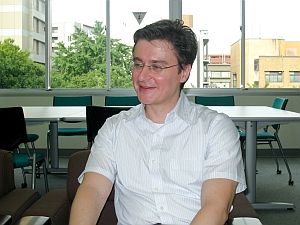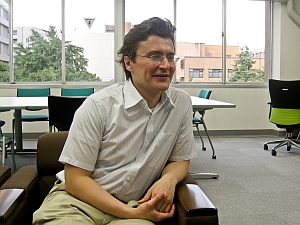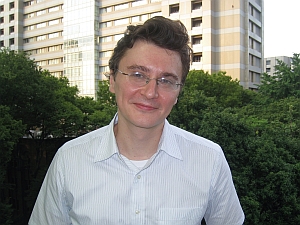Faculty Interview 31
Kerim Yasar (Princeton Univercity. East Asian Studies-Cotzen / Postdoctoral Fellow)

―― How did you first get interested in studying Japan?
My major as an undergraduate was musicology. At that time I didn't really know much about Japan. I was studying Indian classical music, and also composing electronic music. When I was a fourth-year student, I had a friend who was studying Chinese art history and through him I met a lot of people who were studying various topics in East Asian culture. When I graduated from university, I came to Japan to teach English as an AET at a junior high school in Gifu Prefecture. I began learning Japanese and stayed for about a year. After returning to the United States I decided to continue my study of Japanese and Japanese culture. I took some Japanese courses, and applied for a Monbusho scholarship to study at Tokyo National University of the Arts, where I continued to study ethnomusicology. I stayed for about two and a half years. After that I went to Columbia University to begin graduate school, where I started off studying pre-modern Japanese literature, Edo-period haikai in particular, but I soon decided to switch to modern Japanese literature.
――Your Princeton University profile says that you’re studying auditory media in Japan. Could you tell us a little about that?
After I entered graduate school at Columbia University, and as my research progressed, I became more interested in combining my previous interests in music, sound, electronic music, and electronic technologies with my research in Japanese culture. That interest evolved into my current book project, a cultural history of auditory media in prewar Japan that covers the telephone, telegraph, radio, phonograph, and sound cinema. These different technologies transmitted the voice across space and preserved it in time. The human voice became a material artifact. Before then the voice had been immaterial, a transient phenomenon that you couldn't grasp or hold. But I believe that once the human voice became a material artifact, that had very powerful consequences for the practice of culture. I try to explore those consequences in the Japanese context by looking at the discourses that arose around these media technologies.
One example of this is the relationship between the telephone and telegraph and the genbun itchi language-reform movement in Meiji Japan, which was an attempt to bring spoken and written language together. Of course there were many spoken Japanese languages, there were many different dialects, and there were many different forms of written Japanese, so it was not a simple process of transforming a spoken language that everybody shared into a written language everybody shared. It was a two-way process: both the spoken and written languages had to be “invented” in a kind of dialectical relationship with one another.
The dynamics of language reform in Meiji Japan have already been explored in existing scholarship, but what I'm trying to contribute to that discussion is that technologies such as the telegraph, telephone, and phonograph placed a new premium on phoneticism and phonocentrism. For example, in Japan telegrams were composed in kana. In China, on the other hand, messages in kanji had to be encoded and decoded on the sending and receiving ends, an expensive and time-consuming process. But in the case of Japan, a syllabary, a phonetic writing system, already existed, and the fact that it meshed so well with the new technology helped fuel the phonocentric tendencies of the period.

I'm looking at the whole prewar period, from Meiji to the end of the World War II, so another very important medium is radio, which I consider from a number of directions. One of my focuses is radio drama, which was new literary genre only made possible by the new medium. A number of Japanese intellectuals at that time wanted to explore the possibilities of the new genre and formed the Rajio dorama kenkyūkai or Radio Drama Research Group. Members of this group included famous authors such Kikuchi Kan and Osanai Kaoru. They had different ideas about the best way to make use of the medium. Osanai Kaoru, for example, believed that the dialogue should be as clear and easy to understand as possible because that was all the audience could rely on. Others felt that radio drama should be more than just a kind of theater play without images—they thought sound effects were just as or more important than dialogue because with sound effects you can create a sense of space and also convey information about what’s happening.
―― I think radio greatly influenced Japanese society and the general public at that time. Could you comment on that?
Radio was important for a lot of reasons. If you look at it from a political or sociological perspective, it was one of the tools used by militarists in Japan to create and sustain an atmosphere of hyper-nationalism. Consider the events that triggered the main waves of radio buying: the Manchurian Incident, the 1932 Olympics in Los Angeles, and the 1936 Olympics in Berlin. The Olympic Games were incredibly important not only because they encouraged people to buy radios, but also because sports broadcasting was a way to “perform” nationalism. Radio elicited passionate responses in real time. When you read a newspaper, you can maintain a certain distance or detachment in relation to the written word. But when Japanese audiences were listening to those broadcasts from Los Angeles and Berlin, the announcers turned the competition between nations into an involving and passionate exercise. You see this even today when you watch broadcasts from the Olympics or the World Cup: The announcers scream,“Nippon Ganbare!”and so on, and viewers get swept up in the sentiment of nationalism. This was already true in the 1930s. It was a way of using the human voice to arouse passion and create a sense of identity, of belonging to certain group: in this case, “Japan” and “the Japanese.”
By the time of 1936 Olympics in Berlin, that technique was very advanced. The 1936 Berlin Olympics were an orgy of nationalism, and Japanese broadcasters did a very good job of creating nationalistic sentiment amongst the listening public. They were reading translations of essays by Goebbels, the propaganda minister for the Nazis, and learning from these examples how to use broadcasting as a tool of political persuasion and control.

―― Through the perspective of radio, we can see various aspects of the Japanese situation at that time!
Yes, you get a sense of the specific historical context. I want to consider the local, culturally- and historically-specific ways in which these media were understood and put to use in Japan. For example, I mentioned the Radio Drama Research Group. No such thing existed in the United States or United Kingdom. I believe it was a product of the Japanese culture of the bundan, a very specific kind of literary community. Of course there were literary communities in England and the United States, but they didn't operate in the same way that the bundan did in Japan. Bundan culture was applied to radio drama in a way that was particularly Japanese.
Another difference: Franklin Roosevelt, Winston Churchill, and Adolf Hitler made radio broadcasts all the time, but there was a taboo against having the Japanese emperor broadcast his voice. This was something quite specific to Japan. One can speculate that this prohibition had roots in traditional ritual and ideas about the auratics of the spoken voice. We see precursors for this in the kotodama discourse of the kokugakusha in the Edo period. The kokugakusha made a distinction between ji or written language, which was associated with China, and koto, the spoken language that was associated with a more purely “Japanese” identity. Of course the proponents of this thinking, the kokugakusha, were perfectly at home in Chinese writing so there was something slightly disingenuous about the split they posited between “foreign” writing and “native” speech, but their embrace of such an ideology is suggestive in itself. I don’t think there’s a direct connection between kotodama ideology and the various ways in which auditory media were used and thought about in prewar Japan, but I would say that these auditory media reactivated a conceptual—if not always deeply experienced—tension between orality and textuality in Japanese culture that’s been around at least since Kūkai.
( responsible for this article : Tomoka MUSHIGA )

